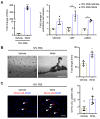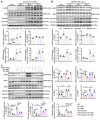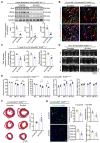Wnt4 is crucial for cardiac repair by regulating mesenchymal-endothelial transition via the phospho-JNK/JNK
- PMID: 35673578
- PMCID: PMC9169355
- DOI: 10.7150/thno.71392
Wnt4 is crucial for cardiac repair by regulating mesenchymal-endothelial transition via the phospho-JNK/JNK
Abstract
Rational: Wnt4 plays a critical role in development and is reactivated during fibrotic injury; however, the role of Wnt4 in cardiac repair remains unclear. In this study, our aim was to clarify the pathophysiological role and mechanisms of Wnt4 following acute cardiac ischemic reperfusion injury. Methods and results: We investigated the spatio-temporal expression of Wnt4 following acute cardiac ischemic reperfusion injury and found that Wnt4 was upregulated as an early injury response gene in cardiac fibroblasts near the injury border zone and associated with mesenchymal-endothelial transition (MEndoT), a beneficial process for revascularizing the damaged myocardium in cardiac repair. Using ChIP assay and in vitro and in vivo loss- and gain-of-function, we demonstrated that Wnt4 served as a crucial downstream target gene of p53 during MEndoT. Wnt4 knockdown in cardiac fibroblasts led to decreased MEndoT and worsened cardiac function. Conversely, Wnt4 overexpression in cardiac fibroblasts induced MEndoT in these cells via the phospho-JNK/JNK signaling pathway; however, both the p53 and Wnt4 protein levels were dependent on the β-catenin signaling pathway. JNK activation plays a critical role in the induction of MEndoT and is crucial for Wnt4 regulated MEndoT. Moreover, Wnt4 overexpression specifically in cardiac fibroblasts rescued the cardiac function worsening due to genetic p53 deletion by decreasing fibrosis and increasing MEndoT and vascular density. Conclusion: Our study revealed that Wnt4 plays a pivotal role in cardiac repair with involvement of phospho-JNK mediated MEndoT and is a crucial gene for cardiac fibroblast-targeted therapy in heart disease.
Keywords: Cardiac ischemic reperfusion injury; Wnt4; cardiac fibroblast; mesenchymal-endothelial transition (MEndoT); p53.
© The author(s).
Conflict of interest statement
Competing Interests: The authors have declared that no competing interest exists.
Figures








Similar articles
-
Mesenchymal-endothelial transition-derived cells as a potential new regulatory target for cardiac hypertrophy.Sci Rep. 2020 Apr 20;10(1):6652. doi: 10.1038/s41598-020-63671-8. Sci Rep. 2020. PMID: 32313043 Free PMC article.
-
Wnt4 negatively regulates the TGF-β1-induced human dermal fibroblast-to-myofibroblast transition via targeting Smad3 and ERK.Cell Tissue Res. 2020 Mar;379(3):537-548. doi: 10.1007/s00441-019-03110-x. Epub 2019 Nov 27. Cell Tissue Res. 2020. PMID: 31776823
-
YBX-1 mediated sorting of miR-133 into hypoxia/reoxygenation-induced EPC-derived exosomes to increase fibroblast angiogenesis and MEndoT.Stem Cell Res Ther. 2019 Aug 23;10(1):263. doi: 10.1186/s13287-019-1377-8. Stem Cell Res Ther. 2019. PMID: 31443679 Free PMC article.
-
Elevated Wnt2 and Wnt4 activate NF-κB signaling to promote cardiac fibrosis by cooperation of Fzd4/2 and LRP6 following myocardial infarction.EBioMedicine. 2021 Dec;74:103745. doi: 10.1016/j.ebiom.2021.103745. Epub 2021 Dec 12. EBioMedicine. 2021. PMID: 34911029 Free PMC article.
-
Experimental Models to Study Endothelial to Mesenchymal Transition in Myocardial Fibrosis and Cardiovascular Diseases.Int J Mol Sci. 2023 Dec 27;25(1):382. doi: 10.3390/ijms25010382. Int J Mol Sci. 2023. PMID: 38203553 Free PMC article. Review.
Cited by
-
The role of JNK signaling pathway in organ fibrosis.J Adv Res. 2025 Aug;74:207-223. doi: 10.1016/j.jare.2024.09.029. Epub 2024 Oct 2. J Adv Res. 2025. PMID: 39366483 Free PMC article. Review.
-
Pathogenesis of Cardiac Valvular Hemangiomas: A Case Report and Literature Review.Int J Mol Sci. 2025 Jul 23;26(15):7114. doi: 10.3390/ijms26157114. Int J Mol Sci. 2025. PMID: 40806246 Free PMC article. Review.
-
ScRNA-seq and spatial transcriptomics: exploring the occurrence and treatment of coronary-related diseases starting from development.Front Cardiovasc Med. 2023 Jun 20;10:1064949. doi: 10.3389/fcvm.2023.1064949. eCollection 2023. Front Cardiovasc Med. 2023. PMID: 37416923 Free PMC article. Review.
-
The role of collagen triple helix repeat containing 1 (CTHRC1) in cancer development and progression.Expert Opin Ther Targets. 2024 May;28(5):419-435. doi: 10.1080/14728222.2024.2349686. Epub 2024 May 11. Expert Opin Ther Targets. 2024. PMID: 38686865 Free PMC article. Review.
-
Stem cell antigen-1+cell-derived fibroblasts are crucial for cardiac fibrosis during heart failure.Cell Mol Life Sci. 2023 Sep 23;80(10):300. doi: 10.1007/s00018-023-04957-8. Cell Mol Life Sci. 2023. PMID: 37740736 Free PMC article.
References
-
- Takahashi K, Tanabe K, Ohnuki M, Narita M, Ichisaka T, Tomoda K. et al. Induction of pluripotent stem cells from adult human fibroblasts by defined factors. Cell. 2007;131:861–72. - PubMed
-
- Takahashi K, Yamanaka S. Induction of pluripotent stem cells from mouse embryonic and adult fibroblast cultures by defined factors. Cell. 2006;126:663–76. - PubMed
Publication types
MeSH terms
Substances
LinkOut - more resources
Full Text Sources
Research Materials
Miscellaneous

